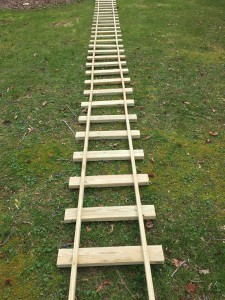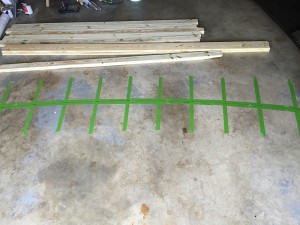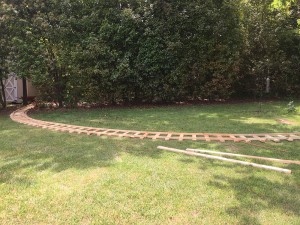Since I’ve never built a train track, I’m sure that I’ll learn more than I’ll ever wanted to know about train tracks by the time I have it completed. I’m also sure that I’ll eventually look back and realize that I would have done some things differently once I’ve gone through the process.
That said, I plan to research as much as I can to reduce the risk that I’ll have to scrap major pieces of work after the fact because I didn’t have the knowledge to do it right the first time.
So, from my reading, here’s some things to be considered when I design and build the track:
- The width between the rails is critical. If the distance between the wheel flanges is 14.5″, then there needs to be another quarter inch added for the distance between the rails so the wheels don’t bind.
- The width between the rails in the curved sections needs to be about one eighth of an inch larger to keep the wheels from climbing the rails and derailing.
- The curved sections can’t be too tight. The degree of curve is expressed as the distance of the radius that would scribe the curve. From reading, it seems that the tightest curve that the train will be able to handle is about a thirty foot radius. If you think about the geometry, the minimum radius of the curve would have to be increased if the wheelbase of the engine increases or as the track width increases. I’m going with the thirty-foot radius and hoping it works out.
- The grade of the track can’t be too steep. It seems from reading that a three or four percent grade is pretty much the maximum that a train should encounter. Because of the slope on the property where the track will go, I may have as much as a twelve or fourteen percent grade. Based on the hill-climbing tests I’ve already conducted, I know the motors have enough power to handle a fifteen percent grade, assuming I can get enough traction to keep the wheels from slipping.
So my general approach to building the track will be to create track sections that can be attached to each other on the track bed. The curve sections will need to reflect a thirty foot radius, so I’ll build some sort of template for those. In addition, I need to ensure that the distance between the two rails is consistent. So I’ll need some sort of template to ensure that the distance between the two rails doesn’t vary as I assemble the track sections.
Once I get some curve sections of track completed, I’ll want to run a test to make sure the engine can handle the curve without derailing. Assuming that test works well, then I can use this approach for the remainder of the curve sections.
I’ll also need to figure out how I want to set the track on the ground. The simplest way would be to just lay the sections on the ground. There may be several problems with this approach, however. The ground is uneven, so the track would be uneven as well. If the track tilts to the side, then the engine will also tilt on that section of the track. Too much tilt and it may fall over. That would be a train wreck. Not good. Also, the grass and weeds will grow between the cross-ties and will be a nuisance to control.
The best approach would be to set the track on a bed of ballast (gravel) to give it the best support and enable me to make leveling adjustments. I don’t want to have to deal with removing tons of gravel at some point in the future, so I’ll start with no gravel and see how it goes. Maybe later, if necessary…
So, let’s get started!






